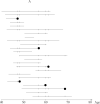Are nested case-control studies biased?
- PMID: 19289963
- PMCID: PMC4194079
- DOI: 10.1097/EDE.0b013e31819e370b
Are nested case-control studies biased?
Abstract
It has been recently asserted that the nested case-control study design, in which case-control sets are sampled from cohort risk sets, can introduce bias ("study design bias") when there are lagged exposures. The bases for this claim include a theoretical and an "empirical evaluation" argument. We examined both of these arguments and found them to be incorrect. We describe an appropriate empirical evaluation method to explore the performance of nested case-control study designs and analysis methods from an existing cohort. This empirical evaluation approach relies on simulating case-control outcomes from risk sets in the cohort from which the case-control study is to be performed. Because it is based on the underlying cohort structure, the empirical evaluation can provide an assessment that is tailored to the specific characteristics of the study under consideration. The methods are illustrated using samples from the Colorado Plateau uranium miners cohort.
Figures







Comment in
-
Bias in full cohort and nested case-control studies?Epidemiology. 2009 May;20(3):339-40. doi: 10.1097/EDE.0b013e31819ec966. Epidemiology. 2009. PMID: 19289961 Free PMC article. No abstract available.
Similar articles
-
Empirical evaluation of complex epidemiologic study designs: workplace exposure and cancer.J Occup Environ Med. 2007 Sep;49(9):953-9. doi: 10.1097/JOM.0b013e318145b28d. J Occup Environ Med. 2007. PMID: 17848851
-
Estimation of excess risk from case-control data using Aalen's linear regression model.Biometrics. 1997 Jun;53(2):690-7. Biometrics. 1997. PMID: 9192457
-
Healthy worker survivor bias in the Colorado Plateau uranium miners cohort.Am J Epidemiol. 2015 May 15;181(10):762-70. doi: 10.1093/aje/kwu348. Epub 2015 Apr 1. Am J Epidemiol. 2015. PMID: 25837305 Free PMC article.
-
Health effects in underground uranium miners.Occup Med. 2001 Apr-Jun;16(2):331-44. Occup Med. 2001. PMID: 11319055 Review.
-
The use of biologically based cancer risk models in radiation epidemiology.Radiat Prot Dosimetry. 2003;104(4):367-76. doi: 10.1093/oxfordjournals.rpd.a006200. Radiat Prot Dosimetry. 2003. PMID: 14579893 Review.
Cited by
-
Beryllium metal II. a review of the available toxicity data.Ann Occup Hyg. 2011 Jan;55(1):43-56. doi: 10.1093/annhyg/meq073. Epub 2010 Dec 31. Ann Occup Hyg. 2011. PMID: 21196456 Free PMC article. Review.
-
Use of systemic hormonal contraception and risk of depression: a registry-based study from Finland.Eur J Epidemiol. 2025 Aug;40(8):915-923. doi: 10.1007/s10654-025-01267-0. Epub 2025 Jul 2. Eur J Epidemiol. 2025. PMID: 40601246 Free PMC article.
-
Bias in full cohort and nested case-control studies?Epidemiology. 2009 May;20(3):339-40. doi: 10.1097/EDE.0b013e31819ec966. Epidemiology. 2009. PMID: 19289961 Free PMC article. No abstract available.
-
Anticholinergic drugs and risk of dementia: case-control study.BMJ. 2018 Apr 25;361:k1315. doi: 10.1136/bmj.k1315. BMJ. 2018. PMID: 29695481 Free PMC article.
-
Weighted metrics are required when evaluating the performance of prediction models in nested case-control studies.BMC Med Res Methodol. 2024 May 17;24(1):115. doi: 10.1186/s12874-024-02213-6. BMC Med Res Methodol. 2024. PMID: 38760688 Free PMC article.
References
-
- Deubner DC, Lockey JL, Kotin P, Powers MB, Miller F, Rogers AE, Trichopoulos D. Re: Lung cancer case-control study of beryllium workers. Sanderson WT, Ward EM, Steenland K, Petersen MR. Am J Ind Med. 2001. 39:133-144 [letter]. Am J Ind Med. 2001;40:284–288. - PubMed
-
- Levy PS, Roth HD, Deubner DC. Exposure to beryllium and occurrence of lung cancer: a reexamination of findings from a nested case-control study. J Occup Environ Med. 2007;49:96–101. - PubMed
-
- Levy PS, Deubner DC, Roth HD. Re: Exposure to Beryllium and Occurrence of Lung Cancer: A Reexamination of Findings From a Nested Case-Control Study [letter]. J Occup Environ Med. 2007;49:709–711. - PubMed
-
- Deubner DC, Roth HD, Levy PS. Empirical evaluation of complex epidemiologic study designs: workplace exposure and cancer. J Occup Environ Med. 2007;49:953–959. - PubMed
-
- Deubner DC, Roth HD, Levy PS. Re: Empirical evaluation of complex epidemiologic study designs: workplace exposure and cancer [letter]. J Occup Environ Med. 2008;50:2. - PubMed
Publication types
MeSH terms
Substances
Grants and funding
LinkOut - more resources
Full Text Sources

